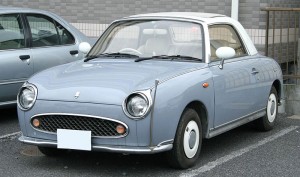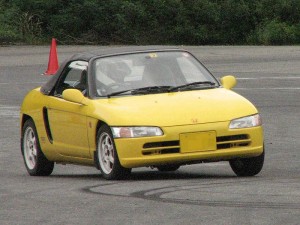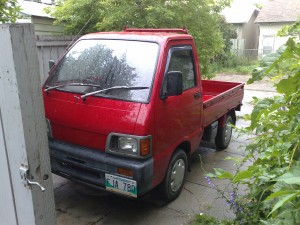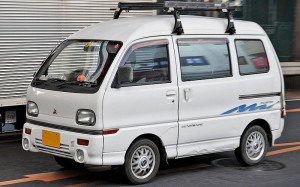The orgins of right-hand drive/left-hand drive
Once again, the cruising of the internet has made an interesting article crop up.
Check it out if you're interested in the origins of right and left hand drive traffic.
http://www.feras.co.uk/when-did-european-cars-change-to-left-hand-drive/
rob
What’s it like driving a right hand drive?
This is a common question. Usually followed up by, "Is it safe to drive a right hand drive?"
Clearly these questions can be translated to, "Is is safe to drive a right hand drive in a left hand drive country?"
The answer really lies with the person behind the wheel. That being said, driving an RHD in a LHD country does have it's gotchas, but they're not as bad as you might expect.
In a straight line, it's the same. It feels strangely not unusual to be 'driving from the passenger seat'. If you think about it, you've sat in the passenger seat of a car quite a few times in your life... now there just happens to be a steering wheel there. But, you know where the car should be sitting on the road and it doesn't feel awkward. Shifting with the left hand (given you have a manual transmission) is also surprisingly natural. And, consider this. The majority of the population is right-handed. Should your dominant hand be doing what's keeping your alive (steering) or not (shifting). So, it actually makes some sense!
In a straight line, it's the exact same dangerousness (let's make up some words!) as driving in the far left lane in a multi-lane one-way. Really, not that hard.
Where you will get a little hung up is turning. Left turns across large intersections can be a little tricky. Usually, in a LHD, you can nose in and try to look past the vehicle across the intersection that's also trying to make a left turn.... even this is often hard in a LHD. In a RHD you're further right in the car and have to nose even further in to see past obstructions. It's not often that it's an issue, but it can be.
The blind spots in RHD are similar to LHDs, but the mirror image. One thing that keeps catching me is this: when doing a right-on-red I nose into the intersection and turn a little to the right. This shifts my passenger up a bit and no they're in my line of sight. Easy to fix. Either lean forward, ask them if there is traffic, or don't have a passenger. After a bit you don't do that any more. There are the same problems when you're driving a LHD, but you don't think about them anymore. The same thing happens in an RHD. You just adjust and forget about it.
There are some publications saying how dangerous RHDs are in LHD traffic. SAAQ (Quebec's public insurance) has published a document detailing their statistics in attempts to show that RHDs are a menace on the roads. I feel that this document is flawed, but won't get into that right now. They make some good point, and is overall a good read. I don't think that it's sufficient evidence to stop insuring RHDs.
ICBC (BC's public insurance) has published a document in the same vein as SAAQ. ICBC has acknowledged that the findings are difficult to interpret since there are no sure-shot ways of discovering whether or not a car that is insured is right hand drive or not.
Both of these documents have their valid points. There is major points for skew though. They, again, are worth the read.
Overall, it's the same, just different. It's no more dangerous than any other vehicle if you're paying attention and not driving like a moron. Some (maybe even most) of these cars that are brought in are high power cars that are difficult to not drive like a moron. This might be the problem, but it's a problem with the drivers, not the cars.
rob
Kei Vehicles
A somewhat new sight on North American roads are Kei class vehicles. These vehicles come in many forms including trucks, vans and even cute little cars. They are cars that qualify for special insurance rates in Japan, much like scooters have in most provinces. There are restrictions on the vehicle's height, length, weight, power and engine size. Due to these restrictions the vehicles, especially the trucks, are quite utilitarian. It's quite obvious why Japan would encourage the use of these vehicles in Japan. Their emissions are minimal and they're small. If your country has a dense population like Japan the benefits are huge.
The really great things about these vehicles is the options. Since they're so limited in so many ways the manufacturers have beefed them up in different ways. Most of the trucks have options like Four Wheel Drive with diff lock. Some of the trucks have factory dump truck beds (which is ridiculous and amazing to watch) and... AM radios. I listen to a lot of CBC now.
Kei Cars
The cars are much less utilitarian, and easily the cutest vehicles on the road. The Nissan Figaro is the prime example of this. It's the first right hand drive car I remember seeing. It blew my mind in how it didn't look like any car I'd ever seen in real life. If Minnie Mouse drove a car in real life, this would be it. And that's not an insult. Honestly, I'm not sure if it's actually a Kei car, since it has a 1L engine, which is larger than the 660cc limit on Kei vehicles, but otherwise it meets the requirements. If it's not it deserves an honorable mention.
One car that for sure meets the Kei restrictions is the Honda Beat. A little convertible roadster that shows that a 660cc and 65hp limit doesn't mean it can't be flashy. I've seen one of these booting around Winnipeg and was quite impressed. It has the Civic styling with an inline 3 motor. The engine is mounted behind the driver for a mid engine, rear wheel drive layout. Due to the mid engine mount the car has great weight distribution and fantastic handling. Just because it's a Kei car doesn't mean that it can't be excessively fun.
Kei Trucks
This post wouldn't be complete without a photo of a minitruck. Kei trucks are the workhorse of Japan. They're small, goofy looking and amazing. They can haul about as much as a 1/4 ton truck, can convert into a flatbed and many have four wheel drive. I drive mine (which is the photo) year round in Winnipeg. The four wheel drive handles the Manitoban deep freeze handily. The problem with the trucks is that they're geared down more than the cars. I have a 4 speed in my truck and 100km/h is a bit of a chore. The five speeds are more capable of running at highway speeds. The road noise is an issue for some people. The road noise is pretty noticeable due to the (usually) mid mounted engine. It's right behind the driver and there is very little noise dampening material. Apparently the Subaru Sambar is better than other mini trucks in this regard. It has a rear mounted 4 cylinder as opposed to a mid mounted 3 cylinder. It apparently can do highway speeds handily and isn't too noisy to boot. Parts are the real issue with the (and all) Subarus.
Kei Vans
The last type of Kei vehicle is the micro van. This name has always cracked me up since the trucks are called mini trucks but the vans are micro vans being that mini van was taken. These vans are basically the same as the trucks, sharing many components. They often have four wheel drive with diff lock, just like the trucks. They have much more luxury features like power retracting glass roofs, power windows and nice upholstery (which is very much lacking in the kei trucks). I haven't heard if they are slow like the trucks, but I can only assume that they run about the same speeds as the trucks.
Regulations
Here are the specifications that Kei vehicles must adhere to.
- Maximum Length: 3.3 m
- Maximum Width: 1.4 m
- Maximum Height: 2 m
- Maximum Engine Size: 660cc
- Maximum Horsepower: 63 hp
As taken from Wikipedia, so take it as a grain of salt.
Kei cars are fun, different and hilariously fun. Kids point and laugh at my little red truck regularly since it looks like a big toy. And well, it is! And I love it for that. If you're looking for a right hand drive, don't overlook a Kei car as an option. If you're just booting around the city you can't go wrong.
For an incomplete list of Kei cars click here for Kei trucks click here and for Kei vans click here.
Rob
Right hand drive ban in Nigeria
Lagos, a state in Nigeria, has banned right hand drive vehicles outright (source). Seeing as there are countries that are RHD countries I find that interesting.
The thing that really caught my attention was a quote from the news story I found.
"Lagos state government said it will enforce the ban of unworthy vehicles on its roads as it announced its intention to impound right-hand drive cars." http://allafrica.com/stories/201002160680.html
Those are hurt words. Ouch. I'm sure some of the RHD cars are run down, but that could be any car. I'm not sure if this is an exact quote, or a paraphrasing... but either way... ouch...
Cheers,
rob
What are the controls like in a Right Hand Drive car?
This question isn't as simple as it might seem. I'll tell you what I know, and then I'll tell you what the internet knows.
To get it out of the way I'll tell you straight off that the pedals are in the same order as LHD cars. Accelerator on the far right, then the brake to the left of that and then to the left of that, the clutch... if you have one. So, this carries over no problem.
The shifter is still in the middle of the car. No shocker there. For cars with manual transmissions you'll find that they have the same shift pattern as LHD cars. It's actually quite natural to shift with the left hand. My opinion is that 75%+ of the world is right handed. So, why would we make the majority of the population shift (the easy job) with their dominant hand and drive with the less useful hand?
My radio, though I don't know about others, is backwards. The volume knob is on the far right and the tuner is on the far left.... confuses the heck out of everyone. But that might be a one-off.
Ok, now for the messy part. The signal lights and wiper controls. These are opposite on right hand drive cars. So, you'll probably turn on the wipers when trying to signal a few times in the first week.
BUT
That's only in Japanese vehicles. Or, I should say, the common layout for controls in Japanese vehicles.
I've been told that right hand drives in the UK have the signal controls on the left, much like North American LHDs. The learning curve might be a little simpler for North Americans in this instance. But, after talking to a few Brits before this post it sounds like it's more of a mixed bag of signal light control locations.
If you're considering a right hand drive and are worried about the controls, don't be. I switch between right and left hand cars on a regular basis and it's never an issue. I'd say I choose the wrong control and turn on the windshield wipers about once a month because I switch back and forth... but most people wouldn't even notice that something went wrong as long as you don't panic.
Rob
Is it worth the trouble driving a right hand drive car?
Clearly I am a little biased when asked this question, but I think this question can be answered objectively. The answer lies somewhere in the 'kind of' area. I'll try to break it down into a few areas you should consider before you purchase a right hand drive car.
Parts
This is a major concern for some people, and it should be a consideration when buying a right hand drive vehicle. I, for one, sourced parts while looking for my truck. I was lucky that the guy who imported my truck owns a parts store and said he would stock parts for it. Will he in the long run? Who knows.
Some cars have lots of parts in common with their North American equivalents. I believe the Toyota Hilux is one of these vehicles. Clearly not all parts will be interchangeable, but it very well could save you having to ship a part from a different province, country or continent. Do your research, don't leave it to chance. That cheap Skyline might be appealing, but who knows how much it's going to cost you to maintain it.
Service
This one, in general, is quite easier. Be prepared for funny looks. When I'm at Canadian Tire trying to get simple things, like a new battery, they ask me for a make and model. Every time I say "It's not in your system". They generally say, "Try me". Great. Ok. Daihatsu Hijet. They don't even know how to spell it. Sigh. I tried to save them the embarrassment.
What you should do is, again, your research. Find the bolt pattern, battery size or whatever online before you just stumble into a parts store and get blank looks from the clerk. The internet is your friend here. The information can be dicey at times, but it's a huge resource. Once you find what you need, a strategy to handle useless clerks is to find a car/truck/boat (yes... boat. It's worked for me in the past) that has similar parts and just say you have that. Work the system.
Insurance
I'm lucky I live in Manitoba. We have 'Public Insurance". At first I was worried my truck wouldn't be in the system and that it would be a big hassle. Turns out it was in their system and it was simple to insure. I know that Quebec currently has a hold on all right hand drive vehicles, but I believe they are legal to drive in all other provinces. In general the insurance is comparable to other cars in its class. Shop around.
Driving one
Is it more dangerous to drive a right hand drive? No.
But the stats say that you're 40% more likely to have an accident! Yeah, but I'll bet those are all 16-30 year old dudes that would have done the same in a tuned left hand drive.
It's different, and occasionally awkward. Once you're used to driving one you adjust to avoid putting yourself in these awkward places. Just like driving a left hand drive, there are positions you avoid. You could say this about any car. They all have blind spots and you work around them. Every car is different, but I know that I don't turn into a right hand turn before I can go because my passenger becomes a blind spot. So, I just don't do that.... shocking! Be smart. Drive safe. In the end it's just a car and has all the same odd things.
What about the McD's Drive Through!
Yeah.. about that. This is part of the adjusting. Consider avoiding the McD's drive through a health measure.
Other things you'll have to avoid/think through/have a passenger for:
- Parkades. This one sucks. Running around the car to get the ticket to enter - running back to get in the car soon enough so the arm doesn't drop. Not classy.
- Drive through ATMs.
What about the Police?
There are horror stories about right hand drivers getting pulled over weekly. I, personally, haven't been pulled over yet. I've gotten some confused looks from the police, but nothing too serious. But, my Kei truck isn't.... fast... at all.
If you are considering buying a twin turbo Fairlady Z, Skyline or other Japanese uber-sports car and put racing stickers on it.... chances are you're going to get pulled over. If you're driving one of these cars like a moron... you're GOING to get pulled over.
Right hand drive cars are more noticeable... by jealous onlookers and the cops. If you don't want to be noticed, then buy yourself a Ford Taurus. Buying a flashy car has some strings attached.
So, is it worth it?
Yes.
It's not all glamour and awesomeness. There are special issues that come with the turf. You'll look like an idiot when you go to a parkade. You'll never go through a drive through alone again. But, they're fun. They're low mileage. They're different.
I, for one, love my truck. And, in the end if I ever want to go through a drive through again I could buy a cheap beater LHD or (god forbid) sell my truck one day. But for now, I think it's the greatest thing ever.
Rob



